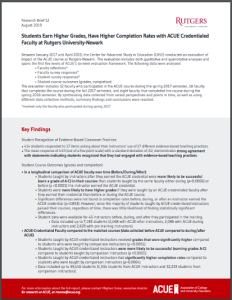
“Having the Time of My Life”: The Trickle-Down Model of Self and Student Engagement
 Looking back at my undergraduate education, I now fondly remember a physiological psychology course. It met early, at what felt like 5:30 a.m. Although I needed several cans of Mountain Dew to wake up and get there, I never considered missing a class. It wasn’t that the professor had a strict attendance policy, or the caffeine high, or that I was an exceptionally disciplined student (I wasn’t). It was the professor’s engagement.
Looking back at my undergraduate education, I now fondly remember a physiological psychology course. It met early, at what felt like 5:30 a.m. Although I needed several cans of Mountain Dew to wake up and get there, I never considered missing a class. It wasn’t that the professor had a strict attendance policy, or the caffeine high, or that I was an exceptionally disciplined student (I wasn’t). It was the professor’s engagement.
Every morning, Dr. Ed Yeterian would have the time of his life. He would discuss brain areas, their locations, and their functions with obvious and unbridled excitement. I never considered missing class because his engagement in his material was contagious. I wanted to learn more because he genuinely wanted to teach it. His engagement fueled my engagement, and I did far better in the class than I might have otherwise.
The Trickle-Down Engagement Model
Inspired by the experience with Dr. Yeterian, my graduate students and I wondered about the effects of teacher engagement. The scholarship of teaching and learning (SoTL) focuses on ways to increase student engagement. We reasoned that if teachers were thoroughly and genuinely engaged in their content, then their engagement would trickle down, with students empathizing with that engagement and consequently being more engaged themselves. We also predicted that this process would positively impact student learning and manifest in various learning assessments.
My graduate students and I developed a research program to test empirically the predictions of our Trickle Down Engagement Model, with findings that supported our predictions. We found consistently that as students perceive their teachers to be more engaged in the content they teach, students themselves report being more engaged in that content. Further, as a professor’s level of engagement increases, so does student performance across a variety of learning assessments including quizzes and exams.
| Listen to Don Saucier on Bonni Stachowiak’s Teaching in Higher Ed podcast. |
Ways to Be More Engaged in Your Teaching
Teaching is only one of my responsibilities, but I find it—and work to make it—the most enjoyable. Focusing on your own engagement may sound selfish. However, when instructors focus on our own intrinsic motivation for the teaching experience, the data show that it will not only be better for us; it’s better for our students, too.
Our research also identified ways to be more engaged in your teaching that can be easily incorporated in any class. Some of our favorites include:
• Consider and promote the value of the material. Share with your students your reasons for why you decided to include particular content in your syllabus. Or if the course was developed by a curriculum designer, why your field considers the material important. Let them know that scholars have spent their careers uncovering the knowledge you’ll be discussing. Help your students consider the context of that information in the curriculum, your field, and the world.
• Use “cue statements” to indicate your own engagement. Your engagement should be palpable if it’s to trickle down to students. Throughout your discussions, use “cue statements” to explain why you believe the material is “interesting,” “important,” “relevant,” “valuable,” and “engaging.”
• Be authentic. This process doesn’t work if you are not genuinely engaged in your content and in teaching it. If you don’t know why a section of your course content is engaging, perhaps speak with a colleague who does. Find the reason why—and if you can’t, you may want to reconsider why it’s assigned.
• Embrace teaching as an oasis. Our classes—in rooms or online—can be amazing places. The rest of the world—university politics and budget issues, the seemingly unfair demands of peer reviewers, one’s cranky children—all have to wait while we teach and learn with our students. This time is an opportunity to share the ideas we love and inspire others to love the exploration too. I thank my students, on a regular basis, for this opportunity.
Engage!
As college instructors, we have the best job in the world. We get to share with our students the aspects of our fields that captivated our own attention as students. I walk into class excited to teach every day. I get to share not only the information, but also my love for it and for teaching it. I get to focus on enjoying my teaching experience. Consistent with our Trickle Down Engagement Model, my students also engage more and perform better. By focusing on my own engagement, I am able to create both a more enjoyable experience for myself and a more transformative experience for my students, just like Dr. Yeterian did for me as his face lit up while discussing the frontal lobe on those early mornings long ago.
Donald A. Saucier, Ph.D., is a professor of psychological sciences and University Distinguished Teaching Scholar at Kansas State University. Dr. Saucier is featured in ACUE’s module “Promoting a Civil Learning Environment.” His social psychological research examines the factors that contribute to expressions of antisocial and prosocial behavior, and he is interested in the processes behind faculty and student engagement in teaching and learning. He also shares skills and techniques in his “Engage the Sage” videos.


